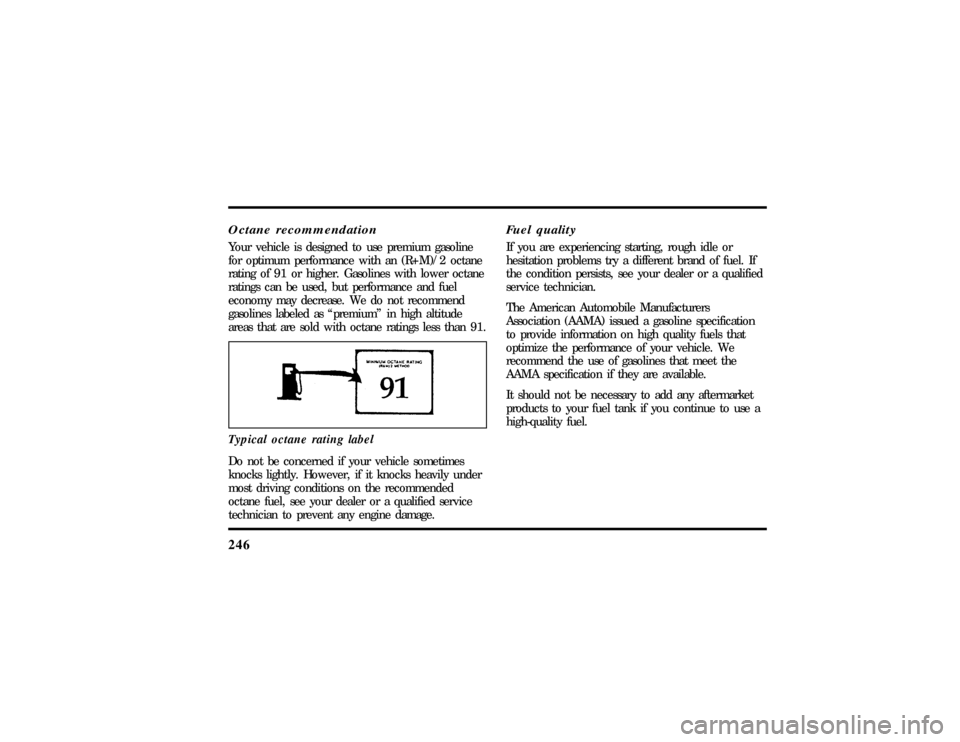Page 251 of 315

246Octane recommendationYour vehicle is designed to use premium gasoline
for optimum performance with an (R+M)/2 octane
rating of 91 or higher. Gasolines with lower octane
ratings can be used, but performance and fuel
economy may decrease. We do not recommend
gasolines labeled as ªpremiumº in high altitude
areas that are sold with octane ratings less than 91.
Typical octane rating labelDo not be concerned if your vehicle sometimes
knocks lightly. However, if it knocks heavily under
most driving conditions on the recommended
octane fuel, see your dealer or a qualified service
technician to prevent any engine damage.
Fuel qualityIf you are experiencing starting, rough idle or
hesitation problems try a different brand of fuel. If
the condition persists, see your dealer or a qualified
service technician.
The American Automobile Manufacturers
Association (AAMA) issued a gasoline specification
to provide information on high quality fuels that
optimize the performance of your vehicle. We
recommend the use of gasolines that meet the
AAMA specification if they are available.
It should not be necessary to add any aftermarket
products to your fuel tank if you continue to use a
high-quality fuel.
File:11fnmc8.ex
Update:Thu Jun 20 14:28:32 1996
Page 254 of 315

249
To calculate fuel economy:
1. Fill the tank completely and record the initial
odometer reading.
2. Every time you buy fuel record the amount (in
gallons or liters) purchased.
3. After at least three to five tankfuls, fill the fuel
tank and record the final odometer reading.
4. Use these equations to calculate your fuel
economy.q
English: MPG = (total miles)/(gallons used).
q
Metric: L/100K = (liters used) x 100/(total
kilometers)
Comparisons With Environmental
Protection Agency (EPA) and Transport
Canada (TC) Fuel Economy EstimatesEPA fuel economy figures are obtained from
laboratory tests under simulated road conditions and
may not reflect the actual conditions you experience
or your style of driving. The EPA fuel economy
estimate is not a guarantee that you will achieve
the fuel economy shown.
The following decrease fuel economy:q
Lack of regular, scheduled maintenance
q
Rapid acceleration and excessive speed
q
Driving with your foot on the brake
q
Sudden stops
q
Extended engine idling
q
Using speed control in hilly terrain
File:11fnmc8.ex
Update:Thu Jun 20 14:28:32 1996
Page 256 of 315

251
To make sure that the catalytic converter and the
other emission control parts continue to work
properly:q
Use only premium unleaded fuel.
q
Avoid running out of fuel.
q
Do not turn off the ignition while your vehicle
is moving, especially at high speeds.
q
Do not push start your vehicle.
q
Have the services listed in theMaintenance
Schedulebooklet performed according to the
specified schedule. The scheduled maintenance
services are required because they are
considered essential to the life and performance
of your vehicle and to its emissions system.In general, maintenance, replacement, or service of
the emissions control devices or systems in your
new Ford Motor Company vehicle or engine may
be performed at your expense by any automotive
repair establishment or individual using automotive
parts equivalent to those which your vehicle or
engine was originally equipped.
Ford strongly recommends the use of genuine Ford
replacement parts. If other than Ford or Motorcraft
parts or Ford authorized remanufactured parts are
used for maintenance replacements or for the
service of components affecting emission control,
such non-Ford parts should be equivalent to genuine
Ford Motor Company parts in performance and
durability. It is the owner's responsibility to
determine the equivalency of such parts. Please
consult your warranty booklet for complete
warranty information.
File:11fnmc8.ex
Update:Thu Jun 20 14:28:32 1996
Page 258 of 315

253
How to Prepare Your Vehicle for
Inspection/Maintenance (I/M) TestingIn some localities it may become a legal
requirement to pass an Inspection/Maintenance
(I/M) test of the On-Board Diagnostic (OBD) II
system. If the vehicle's powertrain system or its
battery has just been serviced, the OBD II system is
reset to a not ready for I/M testing condition. To
prepare for I/M testing, the law specifies that
additional mixed city and highway driving is
required to complete the check of the OBD II
system.
The driving modes required to reach the ready
condition consist of a minimum of 30 minutes of
city and highway driving as described below:q
At least twenty minutes driving in stop and go,
city type traffic with at least four idle periods.
q
At least ten minutes of driving on an
expressway or highway.Before completing the above driving modes, the
engine must be warmed up and at operating
temperature. Once started, the vehicle must not be
turned off during these driving modes.
Lights and Bulb ReplacementIt is a good idea to check the operation of the
following lights frequently:q
headlamps
q
high-mount brakelamp
q
tail lamps
q
brakelamps
q
hazard flasher
q
turn signals
q
license plate lamps
File:11fnmc8.ex
Update:Thu Jun 20 14:28:32 1996
Page 272 of 315

267
Engineq
Start engine every 15 days. Run at fast idle
until it reaches normal operating temperature.
q
With your foot on the brake, shift through all
the gears while the engine is running.
Fuel systemq
Fill fuel tank with high-quality, premium
unleaded fuel until the first automatic shutoff of
the fuel pump nozzle.
NOTE:During extended periods of vehicle storage
(60 days or more), fuel may deteriorate due to
oxidation. This can damage rubber and other
polymers in the fuel system and may also clog small
orifices.Ford Gas Stabilizer should be added whenever
actual or expected storage periods exceed 60 days.
Follow the instructions on the label. The vehicle
should then be operated at idle speed to circulate
the additive throughout the fuel system.
A volatile corrosion inhibitor added to the fuel
system will protect the fuel system's inner surfaces
from corrosion. Follow the instructions packaged
with the product.
Cooling systemq
Protect against freezing temperatures.
File:12fncs8.ex
Update:Thu Jun 20 14:28:48 1996
Page 282 of 315

278Getting Help Outside the U.S.
and CanadaBefore you export your vehicle to a foreign country,
contact the appropriate foreign embassy or consulate
to make sure local regulations do not prevent you
from registering your vehicle. Officials at the
embassy can also help you decide whether you
should import your vehicle to that country.
Officials at the embassy or consulate can tell you
where to get unleaded fuel. If you cannot get
unleaded fuel or can get only fuel with an
anti-knock index that is lower than your vehicle
needs, contact a district or owner relations office
before you leave the U.S. or Canada.Use of leaded fuel in your vehicle without a proper
conversion may damage the effectiveness of your
emissions control system and may cause engine
knocking or serious engine damage. Ford Motor
Company is not responsible for any damage that is
caused by use of improper fuel.
You may also have difficulty importing your vehicle
back into the U.S. if you use leaded fuel.
File:14fnhs8.ex
Update:Wed Jun 19 15:06:24 1996
Page 284 of 315
281
AccessoriesFord Accessories for Your VehicleA wide selection of accessories is available through
your local authorized dealer. These fine accessories
have been engineered specifically to fulfill your
automotive needs. They are custom designed to
complement the style and aerodynamic appearance
of your Ford-built vehicle. In addition, each
accessory is made from high quality materials and
meets or exceeds Ford's rigid engineering and safety
specifications. That is why Ford brand accessories
are warranted for up to 12 months or 12,000 miles
(20,000 km), whichever comes first. See your
dealer for complete warranty information and
accessory availability.
Ford has many fine products available from your
dealer to clean your vehicle and protect its finishes.
For best results, use the following, or products of
equivalent quality:
File:15fnac8.ex
Update:Wed Jun 19 15:06:40 1996
Page 286 of 315

283
NOTE:The Federal Communications Commission
(FCC) or the Canadian Radio Telecommunications
Commission (CRTC) regulates the use of mobile
communications systems Ð such as two-way radios,
telephones, and theft alarms Ð that are equipped
with radio transmitters. Any such equipment
installed in your vehicle should comply with FCC
or CRTC regulations and should be installed only by
a qualified technician.
NOTE:Mobile communications systems may harm
the operation of your vehicle, particularly if they are
not properly designed for automotive use or are not
properly installed. For example, when operated,
such systems may cause the engine to stumble or
stall. In addition, such systems may themselves be
damaged or their operation affected by operating
your vehicle. (Citizens band [CB] transceivers,
garage door openers, and other transmitters whose
power output is 5 watts or less will not ordinarily
affect your vehicle's operation.)NOTE:Because we have no control over the
installation, design, or manufacture of such systems,
Ford cannot assume responsibility for any adverse
effects or damage that may result if you use this
equipment.
File:15fnac8.ex
Update:Wed Jun 19 15:06:40 1996